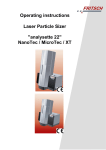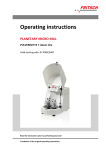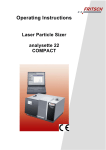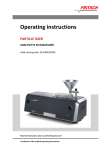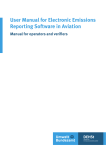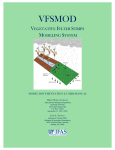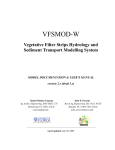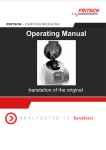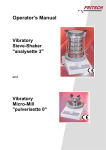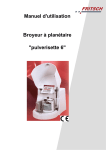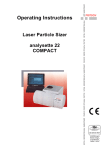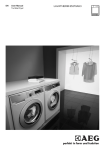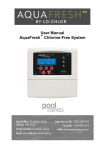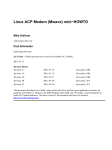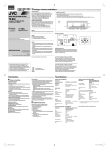Download Operating Instructions - John Morris Scientific
Transcript
Operating Instructions Laser Particle Sizer "ANALYSETTE 22" MicroTec plus Fritsch GmbH Milling and Sizing Industriestrasse 8 D - 55743 Idar-Oberstein Phone: Fax Email: URL: (+49) 6784/ 70-0 (+49) 6784/ 70-11 [email protected] http://www.fritsch-laser.com Fritsch GmbH, Laborgerätebau is certified by the TÜV Zertifizierungsgemeinschaft e.V. under certificate registration no. 71 100 4 008 Based on an audit report, Fritsch GmbH has been awarded the certificate of compliance with the requirements of DIN EN ISO 9001:2000. The enclosed conformity declaration specifies the directives fulfilled by the laser particle sizer "analysette 22 MicroTec plus" in order to carry the CE symbol. MicroTec plus model numbers: 22.8400.00 22.8500.00 Applicable as of serial number 0001 Version 03/2009 Index 000 Created Inspected and approved Table of Contents Page 1 Safety Instructions and Use .............................................................................................1 1.1 1.2 1.3 1.4 1.5 General Information .....................................................................................................................1 Use ..............................................................................................................................................1 General ........................................................................................................................................1 General Safety Instructions .........................................................................................................2 Device Safety Instructions ...........................................................................................................4 1.5.1 Laser ...............................................................................................................................................4 1.5.2 Ultra-Sound Bath.............................................................................................................................5 1.6 Operators.....................................................................................................................................5 1.7 Safety Equipment ........................................................................................................................5 1.8 Electrical Safety ...........................................................................................................................5 1.8.1 General ...........................................................................................................................................5 1.8.2 Overload Protection.........................................................................................................................5 2 Technical Data ................................................................................................................... 6 3 Installation.......................................................................................................................... 6 3.1 3.2 3.3 3.4 3.5 Transport and Storage.................................................................................................................6 Unpacking....................................................................................................................................6 Setup ...........................................................................................................................................9 Accessory Case.........................................................................................................................10 Electrical Connection.................................................................................................................11 3.5.1 Electrical Fuses .............................................................................................................................11 3.5.2 Stability of the Power Supply.........................................................................................................11 3.5.3 Adapting to the Power Network .....................................................................................................11 3.6 Connections...............................................................................................................................12 3.6.1 Measuring Unit Connections .........................................................................................................12 3.6.1.1 Mains Connection ...........................................................................................................12 3.6.1.2 Connecting the Dispersing Unit .......................................................................................12 3.6.2 Liquid Dispersing Unit Connections...............................................................................................13 3.6.2.1 Mains Connection ...........................................................................................................13 3.6.2.2 Installing Hose Connections............................................................................................14 3.7 Preparing the Computer ............................................................................................................14 3.7.1 Installation of the Driver Software..................................................................................................15 3.8 Checking the Communication....................................................................................................18 4 Liquid Dispersing Unit ....................................................................................................19 4.1 4.2 4.3 4.4 4.5 4.6 Changing the Measuring Cell ....................................................................................................19 Changing a Hose .......................................................................................................................21 Selection of the Liquids .............................................................................................................21 Dispersion of Hydrophobic Samples .........................................................................................23 Measurement of Weakly Soluble Samples................................................................................23 The Measuring Cell ...................................................................................................................23 5 Cleaning............................................................................................................................ 24 5.1 Cleaning the Devices.................................................................................................................24 5.2 Cleaning the Measuring Cell .....................................................................................................24 5.2.1 5.2.2 5.2.3 5.2.4 Preparation....................................................................................................................................24 Emptying the System ....................................................................................................................24 Disassembling the Measuring Cell ................................................................................................24 Cleaning the Windows...................................................................................................................27 5.2.4.1 Loose Window.................................................................................................................27 5.2.4.2 Fixed Window..................................................................................................................28 5.2.5 Flow Disk.......................................................................................................................................28 5.2.6 Seal Rings.....................................................................................................................................28 5.2.7 Installing the Measuring Cell .........................................................................................................28 "analysette 22" MicroTec plus Table of Contents Page 5.3 Filling the Measuring Cell ..........................................................................................................29 5.3.1 Liquid Dispersing Unit ...................................................................................................................29 5.3.2 When Using the Small Quantity Dispersing Unit ...........................................................................29 6 Accessories...................................................................................................................... 30 6.1 "MaScontrol" Software Package................................................................................................30 6.2 Small Quantity Dispersing Unit..................................................................................................30 6.2.1 Connecting the Small Quantity Dispersing Unit.............................................................................30 6.2.2 Manual Changing of the "Liquid" Measuring Cell for the Small Quantity Dispersing Unit ..............31 7 Maintenance ..................................................................................................................... 31 8 Warranty ........................................................................................................................... 32 9 Troubleshooting ..............................................................................................................32 9.1 Error List ....................................................................................................................................32 9.2 Transferability of Measurement Results....................................................................................32 10 Disclaimer......................................................................................................................... 33 "analysette 22" MicroTec plus 1 Safety Instructions and Use 1.1 General Information These operating instructions are intended for persons who are charged with the operation and supervision of Fritsch laser particle sizers. All operators must be familiar with the contents of the operating instructions. For this reason, it is very important that these operating instructions actually be provided to these persons. It must be ensured that the operating instructions always remain within easy reach of the instrument. Fritsch has prepared and inspected these operating instructions with great care. Nevertheless, no warranty can be made regarding the completeness or absence of errors. All commissioning, maintenance and repair work may only be performed by qualified personnel! Subject to technical changes. 1.2 Use The laser particle sizer ANALYSETTE 22 MicroTec plus is a universally usable instrument for determination of the particle size distribution of suspensions, emulsions and solids. It is primarily used in research and development and in quality and process inspections. The ANALYSETTE 22 MicroTec plus makes use of the FRITSCH patent on a positionable measuring cell in a convergent laser beam for determination of the particle size distribution. The laser particle sizer described here is a system for use in an industrial environment. During operation, parts of the system exhibit dangerous current levels and laser radiation sources. As a consequence, unauthorised removal of required covering elements or insufficient maintenance can result in serious injuries or material damages. 1.3 General Fritsch GmbH, Laborgerätebau retains the copyright to these technical documents. These operating instructions are not to be reprinted or copied without the express approval of Fritsch GmbH. The laser particle sizer was designed from the perspective of user safety, however some risks could not be excluded. Follow the instructions given here to avoid risks to users. The symbols in the right hand margin highlight the risks described in the text. Some symbols are also found on the device and warn against possible hazards existing there. Warning symbols are surrounded by a triangle. These operating instructions do not constitute a complete technical description. They describe only the details required for safe operation and maintenance for usage under normal conditions. "analysette 22“ MicroTec plus Page 1 1.4 General Safety Instructions The following symbols are used in this description to refer to important information and possible dangers. Caution! Warning against a danger source Follow the operating instructions Caution! Mains voltage Caution! Risk of explosion Caution! Inflammable substances Caution! Warning against laser beam! Wear safety goggles! Spraying with water forbidden! Warning against hand injury! "analysette 22“ MicroTec plus Page 2 • • • • • • • • • • • Read the operating instructions carefully. The device may only be used for the purpose described above. Do not remove the instruction labels Care must be taken to prevent accidents during all work. Independent conversions of the device negate the conformity with European directives declared by Fritsch and void the warranty.. When measuring oxidisable substances, such as metals, organic substances, wood, coal, plastics, etc., the risk of spontaneous combustion (dust explosion) exists if the fine portion exceeds a certain percentage. For this reason, special safety measures (e.g. measurement in suspension) must be taken and the work must be supervised by a specialist. In addition, the maximum workplace concentration values of the pertinent safety regulations must be observed, and sufficient ventilation must be ensured or the device must be operated under a hood. The device is not designed with explosion protection and is not suitable for measuring explosive, combustible or firepromoting substances. The device may not be used in an electrically conducting, dust-containing or moist environment. Do not allow any liquids to enter the device. Do not use any highly flammable, burnable liquids such as alcohols, ketones, benzines, etc. "analysette 22“ MicroTec plus Page 3 1.5 Device Safety Instructions 1.5.1 Laser The measurement unit of the ANALYSETTE 22 MicroTec plus contains two semiconductor lasers, each with 7 mW output and a wavelength of 532 nm or 940 nm. Accordingly, when removed from the housing or if the housing itself is removed, the lasers of the ANALYSETTE 22 MicroTec plus are classified as Class 3b EN 60825-1/11.2001, and the laser emitters may only be operated under the purview of the safety regulations of the German Trade Supervisory Office if the corresponding safety instructions of EN 60825 Part 1 and 2 are observed. The user must familiarise himself with the hazards involved with laser emitters before using the device. Laser devices of laser classes 3B and 4 are hazardous to the human eye; even an exposure time of 0.25 s is sufficient to cause permanent damage to the retina. For this reason, any person operating the device with opened housing must wear suitable safety goggles. The safety goggles must be suitable for the wavelength of the lasers used. Warning labels regarding the laser emissions are located on the side parts of the device. WARNING: • Never look into the laser beam. • Never place reflective objects within the laser beam. • Wear appropriate safety goggles during maintenance or calibration work on the open laser emitter. (< 10 mW, 532 and 940 nm). • The device equipped with a laser emitter may only be operated by authorised personnel. • The user of the device must familiarise himself with the hazards involved with laser emitters before using it. • Do not remove information and warning signs. Appointing of a laser safety officer for the ANALYSETTE 22 is not necessary since the emission sources are fully enclosed and inaccessible as with a laser printer or DVD player. The ANALYSETTE 22 MicroTec plus is classified according to EN 60825 under laser safety class 1. Important: The laser is automatically deactivated upon removal of the measuring cell insert. "analysette 22“ MicroTec plus Page 4 1.5.2 Ultra-Sound Bath The ultra-sound bath built into the liquid dispersing unit has an output of up to 50 watts. PZT ultra-sound oscillators fastened to the oscillating trough convert electrical energy into mechanical vibrations. Fritsch ultra-sound baths cause the liquid to vibrate at 40 kHz. This causes miniscule vacuum bubbles that implode. This cavitation principle destroys agglomerations. Liquids contain dissolved gasses (e.g. oxygen). Freshly added liquids or liquids remaining in the oscillating trough for longer periods of time should be exposed to ultra-sound for approx. 5 to 15 minutes before use. During the degassing period, the cavitation noise alters, loud degassing noises disappear at the end of the degassing process, the device operates noticeably more quietly. A lower noise level does not mean any subsiding in the ultrasound output, only the end of the degassing process. WARNING! • Do not operate the ultra-sound bath without liquids. • Do not use any flammable liquids (e.g. benzine, solvents) and no chemicals that contain or give off chloride ions (some disinfectants, household cleaners and dishwashing soaps) for dispersion in the stainless steel trough. If working with flammable liquids is indispensable, the liquid may under no circumstances be exposed to ultra-sound and the smallest possible volume of liquid should be used. See section 4.3 Selection of the Liquids. • Do not use aggressive liquids (e.g. acids, salt solutions). • Do not reach into the liquid during ultra-sound emission. • The liquid heats up during longer periods of operation; check the temperature. 1.6 7 Operators The device may only be operated by authorised persons and maintained and repaired by trained experts. Persons under the influence of health impairments, medications, drugs, alcohol or excess fatigue may not operate the device. 1.7 Safety Equipment Safety equipment such as coverings must be used as instructed and may not be disabled or removed. 1.8 Electrical Safety Connect the measuring device to a power supply line protected with a residual current circuit breaker. 1.8.1 General The power switch disconnects the machine from the supply at both poles. 1.8.2 Overload Protection The power supply protection provides overload protection. "analysette 22“ MicroTec plus Page 5 7 2 Technical Data Operating noise The noise level is LpA<70dB(A). Voltage Single-phase AC voltage 100-120 V / 200-240 V ± 10%. Current consumption The maximum current consumption is 0.2 A (measuring unit), 0.4 A (dispersing unit) Power consumption The maximum power consumption is 50 W (measuring unit), 100W (supply unit). Electrical fuses Two fuses of 2 A (measuring unit) and 4 A (dispersing unit) in the connection socket 3 Installation 3.1 Transport and Storage Fritsch laser particle sizers are shipped in cardboard boxes on pallets or in wooden crates. These pallets or crates may not be tipped or stacked. The laser particle sizers must be transported and stored in their packaging and protected against weather and external influences. Transport over larger distances only in a transport box. 3.2 Unpacking Compare your order with the delivery! In the event of incomplete delivery and/or transport damages, inform the shipper immediately and FRITSCH GmbH within 24 hours. Later complaints can no longer be accepted. Only open the boxes while the arrows point upward! Remove the transport packaging as shown in the following pictures. 1. Remove the top lid. "analysette 22“ MicroTec plus Page 6 2. The accessory case is located beneath the lid. Remove the case. 3. Remove the top foam parts. "analysette 22“ MicroTec plus Page 7 4. Lift the measuring unit and liquid dispersing unit out of the moulded foam as shown in the image. This action requires two people. Warning: The top grips are not transport grips; they are intended only for lifting out the measuring cell insert. "analysette 22“ MicroTec plus Page 8 3.3 Setup Place the device indoors on a flat, stabile surface. It is not necessary to fasten the device in place. Please avoid intense heat (sunlight, heaters, etc.), dusty environments and their effects on the interior of the measuring device as well as extreme humidity (>85%). The permissible ambient temperature during operation of the device is 10°C to 35°C. Storage between 1°C and 40°C is possible. If it is expected that the temperature will fall below the permissible temperature range (e.g. for a planned transport), it is essential that the entire suspension circuit (dispersing unit, hoses and measuring cell in the measuring device) first be rinsed thoroughly with ethanol and the liquid then completely removed. The device may not be switched on while cooled below the permissible temperature. After the device has been cooled to temperatures below 10°C, you must wait for the device to warm to ambient temperature before switching it on; condensation in the device can lead to disruptions and damage. You will be able to see characters and graphics on the screen more easily if you select a setup location such that sunlight or artificial light do not fall directly on the image tubes. Sometimes simply turning the monitor "out of the light" will help; partial shadow increases the contrast and helps to prevent eye fatigue. Easy accessibility should be ensured during setup so the device can be operated without difficulty. The setup location must be protected against water. If there exists the risk that a water layer could form on the setup surface in the event of an error, you must select another setup location. If no other location is available, the entire device must be elevated (use riser blocks). "analysette 22“ MicroTec plus Page 9 3.4 Accessory Case The accessory case contains materials and tools for cleaning of the optical glass elements (cleaning fluid, cleaning cloths, compressed air, etc.), replacement screws, hose clips and seals for the measuring cell, tools for assembly and maintenance, a DVD with software, a microfibre cleaning cloth for metal and glass surfaces, internal particle size standards F500, F70, dispersion agents, USB cable, power cord and communication cable. A packing list is enclosed with the case. "analysette 22“ MicroTec plus Page 10 3.5 Electrical Connection Connect the measuring device, the dispersing unit, the computer with monitor and the printer to a power strip each with separate power cables. Important: Connect the power strip to a power supply line protected with a residual current circuit breaker. 3.5.1 Electrical Fuses The measuring and dispersing units each have two device fuses in the power connection sockets. 3.5.2 Stability of the Power Supply Devices with electronic components demand stabile supply voltages (+/- 10% deviation). For weak power networks or networks not safe against errors (voltage peaks due to inductive load changes or switched-mode power supplies), we recommend connecting a voltage stabiliser and filters between the power supply and device (order no. 20.6000.00). 3.5.3 Adapting to the Power Network Manual switching of the voltage ranges on the device is not necessary because the device can be operated with 100-120 V / 200-240 V. The switching is performed automatically. "analysette 22“ MicroTec plus Page 11 3.6 Connections Important: Install the USB driver software before switching on the MicroTec plus for the first time. (See section 3.7.1 Installation of the Driver Software) Only connect the USB cable between the device and the computer after installing the driver software. 3.6.1 Measuring Unit Connections The following connections are located on the back side of the measuring unit: Item 1: Connections for connecting the dispersing units to the measurement unit Item 2: USB port for connecting the measuring unit to the computer 3 4 Item 3: On/off switch Item 4: Power socket 3.6.1.1 Mains Connection Connect the supplied power cord to the main power supply (4). Before connecting the device to your mains network, set the on/off switch to 0, then proceed as described in section 3.5. 3.6.1.2 Connecting the Dispersing Unit Connect the measuring unit to the liquid dispersing unit using the supplied data cable. Plug the cable into one of the connections provided (1) on the back side of the measuring unit. Insert the other end into the socket provided on the back side of the liquid dispersing unit. "analysette 22“ MicroTec plus Page 12 3.6.2 Liquid Dispersing Unit Connections The following connections are located on the back side of the liquid dispersing unit: 1 2 3 7 4 5 8 6 Item 1: On/off switch Item 2: Power socket Item 3: Measuring unit connection Item 4: External pump connection Item 5: Suspension liquid discharge Item 6: Suspension liquid supply (IMPORTANT: max. 0.8 bar ) Item 7: Measuring cell supply Item 8: Measuring cell discharge 3.6.2.1 Mains Connection Connect the supplied power cord to the main power supply (4). Before connecting the device to your mains network, set the on/off switch to 0, then proceed as described in section 3.5. "analysette 22“ MicroTec plus Page 13 3.6.2.2 Installing Hose Connections Caution! Lay all hoses without kinks. The hose connections must be connected pressure-tight with hose clamps. The filling connection labelled "Liquid In" (6) is used for filling of the measuring apparatus. Connect the filling connection to your building water supply via the supplied pressure reducer and hose. Secure the hose to the filling connection using the supplied hose clip. The pressure reducer is permanently set to 0.8 bar. In order to ensure that the rinsing process can be completed properly, you must therefore provide at least 2 bar from your water supply. If you connect the "Liquid In" filling connection (6) with demineralised, filtered water or a liquid reserve reservoir tank, you can connect an external filling pump to the "External Pump" connection (4); the pump will then be switched on and off according to when the device requests water. The following accessories are required for connection of the pump: 86.5500.00 power supply switch box, 22.1870.00 switch box cable. The drain connection (5) labelled with "Drain" is used to discharge used measuring and rinsing liquid from the drain valve. For drainage, use a hose for used suspension fluid with 20 mm internal diameter and secure it to the drain connection with the supplied hose clip. Run the drain hose to the drain of a washbasin or a special collection container for your suspension. Caution! The measuring and rinsing liquid is pumped out of the drain hose with pressure during the rinsing process. Make certain that the hose cannot slide out of the drain or collection container to cause spillage. 3.7 Preparing the Computer The MicroTec plus contains an integrated serial to USB converter that makes it possible to connect the MicroTec plus to an analysis computer via a USB port. This converter requires driver software that is found on the supplied Fritsch DVD. The installation program is located in the directory prg\USB driver MicroTec plus\PL-2303 Driver Installer.exe . Current drivers can also be found on the homepage of prolific: www.prolific.com.tw in the area Support / Download / USB and Firewire. Important: Install the USB driver software before switching on the MicroTec plus for the first time. "analysette 22“ MicroTec plus Page 14 3.7.1 Installation of the Driver Software 1. Run the file PL-2303 Driver Installer.exe. 2. Click on NEXT. 3. Accept the license agreement and click on NEXT. 4. Continue installation. "analysette 22“ MicroTec plus Page 15 5. Complete the installation with FINISH. Connect the measuring unit (which has a USB port in the rear) to a USB port of your computer using the supplied USB cable. Use the main power switches located on the upper rear of each device to switch on first the liquid dispersing unit and then the measuring unit. The wizard for locating new hardware opens automatically. 1. Select "NO, NOT THIS TIME“ Æ "NEXT" "analysette 22“ MicroTec plus Page 16 2. Select "AUTOMATICALLY INSTALL SOFTWARE" Æ Next 3. "CONTINUE INSTALLATION" 4. "FINISH" "analysette 22“ MicroTec plus Page 17 5. 3.8 In Windows, click on the button "START"/"CONTROL PANEL"/"SYSTEM"/"HARDWARE"/"DEVICE MANAGER“. The ports of the Prolific USB-to-serial-communication port are shown there. Make note of the COM port that was assigned by Windows and select this port in the "MaS control" software. Checking the Communication After the USB connection between the measuring device and the computer has been established, you must check the communication. Select MicroTec plus and the appropriate COM port in the configuration menu. Select "Start Measurement" and the SOP with the name "Function Test". Press OK. Now perform a measurement with the Fritsch internal standard sample. Instructions for this can be found in the Fritsch reference manual. "analysette 22“ MicroTec plus Page 18 4 Liquid Dispersing Unit 4.1 Changing the Measuring Cell 1. Remove the cover plate of the measuring cell mount on the measuring unit and place it next to the liquid dispersing unit. 2. Carefully remove the measuring cell insert from the measuring cell mount of the liquid dispersing unit by pulling it out upwards. "analysette 22“ MicroTec plus Page 19 3. Insert the measuring cell insert into the measuring cell mount of the measuring unit. Pay attention to the correct orientation of the measuring cell in the mount: the measuring cell glass with the prism surface must face toward the sensor (to the rear). Attention: When inserting the measuring cell insert, be careful that the measuring cell window is not scratched. Always insert the measuring cell insert vertically. 4. The measuring cell insert is correctly seated within the measuring cell mount if the two guide pins of the measuring cell mount clearly pass through the holes in the grip plate of the measuring cell insert. "analysette 22“ MicroTec plus Page 20 5. 4.2 Close the measuring cell mount of the liquid dispersing unit with the cover panel. Changing a Hose If it is necessary to change a sample hose, pay attention to the labels "To Cell" and "From Cell" on the back side of the liquid dispersing unit and on the measuring cell insert. Only connect together connections with the same label. 4.3 Selection of the Liquids The measuring liquid in the device (supply and measuring unit) only comes into contact with materials that are largely chemically resistant. Certain organic liquids or saturated inorganic salt solutions may be used briefly without damaging the device. The measuring liquid comes into contact with stainless steel, glass, PTFE, Viton (FPM and FKM) and Norprene A-60-G. The standard connection hoses are made of Norprene A-60-G. Fritsch GmbH recommends water as the suspension liquid for the dispersing unit. For measurement of samples incompatible with water, an appropriate liquid may be selected from the following list (see also the Compatibility List section): • Mono-, di- or tryhydric alcohols (except for methanol), e.g. ethyl alcohol, isopropyl alcohol, glycol or glycerine • Benzines (petroleum ether, test benzine, kerosine), • Mineral and organic oils such as petroleum and soy oil, nut oil, olive oil • Cyclic aromatic compounds / ring hydrocarbons (toluene only briefly - rinse out after the measurement) • Alkanes • (Hexane, heptane only briefly - rinse out after the measurement because the connecting hoses will be damaged.) • Formaldehyde • Saturated solutions of inorganic salts "analysette 22“ MicroTec plus Page 21 Samples present in oil (e.g. oils similar to machine oil) do not also have to be measured in oil. Example: Toner in machine oil The sample is first dispersed in ethylene glycol with a drop of tenside (Pril) in the ultra-sound bath. Then a mixture is created 1:1 with water, and this is added to the ultra-sound bath of the laser particle sizer ANALYSETTE 22. Example: Raw cocoa mixture Raw cocoa mixture is typically measured in acetone or benzine (known from the sieving process). Measurement in the ANALYSETTE 22 can also be performed in peanut oil, for instance. Because peanut oil is suitable for use with food, the waste oil can also be used as a lubricant on the rollers, solving the disposal problem. Example: Weakly magnetic materials In general, particle size distributions of magnetic substances cannot be measured in suspensions due to the mutual attraction of the individual particles. However, due to the high sensitivity of the ANALYSETTE 22, very low concentrations - in other words relatively large distances between the individual particles - can be used on one hand, and on the other, substances can also be suspended with high viscosity liquids due to the high power of the centrifugal pump. If larger particles or particles with higher density must be measured, the share of glycerine can be increased up to a ratio of 7:3. In general, liquids up to a viscosity of 30 cPoise can still be pumped without problems by the pump system of the dispersing unit. Before the planned use of other measuring liquids, Fritsch GmbH must first be consulted. In principle, we warn against the use of liquids that are explosive, combustible or hazardous to health - they cannot be recommended. The summary given above is intended only to provide information about the chemical compatibility of the device with respect to liquids. The measuring device and dispersing units are not designed with explosion protection. The following may not be used: Ketones (acetone, propanone, butanone, cyclohexanone), Ether, fluorochlorohydrocarbons, Amines, freon 21-32, methanol, aniline, benzine Chlorohydrocarbons such as ethanoic acid and their derivitives, undiluted acids and bases. "analysette 22“ MicroTec plus Page 22 8 When using measuring liquids hazardous to health, always follow the applicable safety regulations (maximum workplace concentration values) and place the measuring unit and dispersing units in ventilated safety zones if required. The liquid consumption is significantly reduced through the use of the small quantity dispersing unit. 4.4 Dispersion of Hydrophobic Samples Hydrophobic samples can be dispersed despite their waterrepulsing properties if they are first mixed into a paste with a fluid tenside (Pril) and then dispersed in water under constant stirring. Agglomerates are also dispersed more easily and more quickly in an ultra-sound bath because the entire sample is subjected to the ultra-sound. In the circuit of the dispersing unit, only the quantity in the bath is in the area of the ultra-sound. For soil samples, 0.1 - 0.5% sodium pyrophosphate solution is recommended as a dispersing aid, for example. The sample prepared in this way in an ultra-sound bath (e.g. "laborette 17" can be measured in pure water. 4.5 Measurement of Weakly Soluble Samples Even samples that are weakly soluble in liquid can be measured with the laser particle sizer ANALYSETTE 22. To do this, preparation of a saturated measuring liquid is recommended. In this liquid, the particle size cannot change by dissolving - the measurement results therefore remain inaccurate. (However, the saturated solution must be filtered before use.) For very expensive products, it is sometimes worthwhile to identify a replacement substance that takes over the task of "saturating" the measuring liquid. 4.6 The Measuring Cell The measuring cell has angled surfaces on the side facing the detector so that light can leave the measuring cell even with large diffraction angles. The window on this side is firmly attached to the rear measuring cell flange of the measuring cell. The opposite window is loosely inserted into the slot in the front measuring cell flange and can be removed for cleaning. "analysette 22“ MicroTec plus Page 23 5 Cleaning 5.1 Cleaning the Devices The devices can be cleaned with a damp cloth or a microfibre cloth from the accessory case. Do not allow any liquids to flow into the devices. 5.2 Cleaning the Measuring Cell It is normally sufficient to rinse the measuring cell with a clear liquid. To remove stubborn residues, you can also add a cleaning agent to the cleaning liquid. Generally a few drops of a surfaceactive household cleanser (e.g. Pril™ or liquid soap) are sufficient. Mechanically adhering contamination can be rinsed out with the addition of approx. 2 g of fine abrasive. (Household abrasives ATA™, VIM™,....). Oily residues can be rinsed out with a slightly alkaline cleaning agent. The word "window" is used below to refer to the glass elements of the measuring cells. 5.2.1 Preparation Lay out the following: • Tool for cell disassembly • Spatula • Cleaning agent • Lens cleaning paper • Clean paper towels • Spray bottle with distilled water Assemble the tool for disassembly of the measuring cell. 5.2.2 Emptying the System In the program, select "Device Controller" Æ "Drainage“ Æ "Open both“ Æ "Set“. The liquid in the system then drains out. 5.2.3 Disassembling the Measuring Cell Although the measuring circuit should now be completely without liquid, it may be that residual liquid remains in the measuring cell itself. Therefore, you should have a paper towel or something similar ready to directly collect any liquid escaping. "analysette 22“ MicroTec plus Page 24 9 9 1. Lift the measuring cell insert out of the measuring unit and lay it on a prepared piece of paper towel. 2. Open the 4 screws that close the measuring cell in a crosswise pattern. 3. Lift off the "rear" measuring cell flange with the glued in window. "analysette 22“ MicroTec plus Page 25 4. Lay the "rear" flange onto a paper towel with the window (prism) facing up. 5. Remove the outer O-ring and clean the metallic surfaces of the "front" flange. 6. Lift up the measuring cell mount and press the window of the "front" flange out of the measuring cell using a clean paper towel. Place the loose window on the lens cleaning paper with the outside facing down. Caution !!! Do not catch the edges of the window when pressing it out. This could destroy the glass edges. Lodged particles may make the window somewhat difficult to remove. Attempt to tilt it somewhat within the frame when pressing it out by pressing on one side or the other. The windows may only be touched by hand on their edges. "analysette 22“ MicroTec plus Page 26 7. Lift the flow disk out of the "rear" flange using a spatula, being careful not to touch the measuring cell window. Caution: NEVER lay the "rear" flange of the measuring cell on an unprotected surface with the window facing down. This could scratch the optical glass or destroy the anti-reflex coating. This can make your entire measuring cell unusable. 5.2.4 Cleaning the Windows Great care is required for cleaning the windows. The windows may only be touched by hand on their edges. 5.2.4.1 Loose Window The following window cleaning method has proven successful: Rinse the window using the spray bottle of distilled water until no large contamination is visible. Then lay the special paper on the inside of the window and moisten it with distilled water and a drop of tenside (Pril) so that the paper sticks to the glass surface. To "wipe off" the surface, slide the paper off parallel to the surface without pressing the paper against the glass. "analysette 22“ MicroTec plus Page 27 You may need to repeat this wiping process on the glass surface with fresh paper until contamination can no longer be seen. Sample residue that adheres very strongly can be "softened" with a tenside (e.g. Pril™) and very carefully wiped a little with the special paper. Then rinse the window clean with the spray bottle and dab it off carefully onto the dry special paper. You should carefully keep the window covered until it is installed again in the measuring cell. 5.2.4.2 Fixed Window The same applies to the window attached in a fixed position to the "rear" flange as for the loose window. Handle the optical surfaces very carefully. Also clean all metal surfaces and seals very well. Adhering grains can lead to the window not being optimally installed and the laser beam is brought out of calibration by moving of the measuring cell. In extreme cases, a glass can even break during installation. 5.2.5 Flow Disk The flow disk is made of PTFE and must be handled carefully! It must never be subjected to mechanical loads. A bent flow disk cannot be used. You can rinse the flow disk under flowing water. Brush off any adhering particles very carefully with a soft brush. 5.2.6 Seal Rings The seal rings can be rinsed under flowing, particle-free (distilled) water and then dried with lint-free, soft paper. 5.2.7 Installing the Measuring Cell After cleaning the parts, you must reassemble the measuring cell. Assembly of the measuring cell is performed in reverse order: Lay in the loose window with the bluish shimmering anti-reflex coating facing out (there are arrows on the window edges, see image, the arrows point out, toward the anti-reflex coating). You can identify the anti-reflex layer by holding a window at an angle to a fluorescent lamp. If you see the inner border of the window shimmer in a bluish colour, the reflex layer is facing up. The coated side is also marked with an arrow on the edge of the glass. If the inner border appears whitish, the reflex layer is facing down because the light entering into the window does not appear coloured by the anti-reflex layer. Then lay the seal ring into the groove provided for this. "analysette 22“ MicroTec plus Page 28 Lay the flow disk into the rear flange. Then carefully join the two halves of the measuring cell. The screws must be tightened carefully in a cross pattern. You must take care that you "close" the two halves evenly with the four screws. The flow disk situated between the two windows holds the windows in an exactly parallel position. Any contamination remaining between the windows and the flow disk must absolutely be removed first. A particle remaining between a window and the flow disk can lead to breaking of a window when screwing the cell together! It also prevents the windows from being perfectly parallel. If the windows are not parallel, the calibration of the laser beam is disrupted. (The calibration is no longer valid for the entire adjustment range of the measuring cell due to the prism effect of the unparallel measuring cells.) Do NOT tighten any screw all at once! Turn the screws a little tighter in alternation until all screws are tight. If you tighten the screws unevenly, the windows may break. 5.3 Filling the Measuring Cell 5.3.1 Liquid Dispersing Unit Leave the measuring cell laying on a paper towel for now and inspect the measuring cell for gaps in the seal. Select the measurement process "Rinse Before Measurement" and press "Start Measurement". The ultra-sound bath then rinses itself and fills itself with clear measuring fluid. The fill level sensor automatically closes the valve. 5.3.2 When Using the Small Quantity Dispersing Unit Emptying and filling of the small quantity dispersing unit is performed manually. Turn the valve lever to "Drain/Fill". With the supply opened, fresh suspension liquid then flows into the glass container through the connected "In" hose. The liquid level rises while the pump is switched off. "analysette 22“ MicroTec plus Page 29 6 Accessories 6.1 "MaScontrol" Software Package All functions of the MicroTec plus can be programmed and controlled using the "MaScontrol" software package (see the MaScontrol user manual). 6.2 Small Quantity Dispersing Unit 6.2.1 Connecting the Small Quantity Dispersing Unit The small quantity dispersing unit is delivered with a special liquid measuring cell. The dispersing unit has four hose connections labelled with: • "FROM CELL" • "TO CELL" • "IN" • "OUT". "FROM CELL" and "TO CELL" are connected to the measuring cell insert. Connect the hose with the red marking with Æ to cell "IN" on the dispersing unit serves to fill the measuring apparatus and is connected either to a central supply line with, for instance, demineralised, filtered water, or to a storage tank with measuring fluid. "OUT" serves to discharge the measuring and rinsing fluid. "analysette 22“ MicroTec plus Page 30 The hoses are firmly connected on delivery. Should it ever be necessary to replace the hoses, connect "FROM CELL" with the hose connection of the measuring cell insert that is labelled as "From Cell". Connect "TO CELL" to the other connection of the measuring cell correspondingly labelled "To Cell". The measuring liquid flows into the measuring cell from bottom to top. Important: The maximum water pressure in the device is 0.5 bar ! 6.2.2 Manual Changing of the "Liquid" Measuring Cell for the Small Quantity Dispersing Unit The following steps must be followed to switch the device to the small quantity dispersing unit: 1. Remove the measuring cell insert of the normal liquid dispersing unit. 2. Place the small quantity dispersing unit next to the measuring unit. 3. Position the measuring cell insert of the small quantity dispersing unit in the measuring cell mount of the measuring unit. 7 Maintenance The analysette 22 NanoTec and MicroTec requires no maintenance apart from the regular cleaning. Before starting any work in the device, switch off the measuring unit and the liquid dispersing unit and unplug the power cord! "analysette 22“ MicroTec plus Page 31 8 Warranty The warranty card enclosed with the device upon delivery must be completely filled out and returned to the delivering factory so that the warranty can enter into effect. The company FRITSCH GmbH Laborgerätebau, Idar-Oberstein and its "Technical Application Laboratory" or the corresponding national representatives will be glad to offer advice and assistance. Indication of the serial number imprinted on the type plate is required with any questions. The type plate is located on the back side of the liquid dispersing module and measuring module. 9 Troubleshooting 9.1 Error List 9.2 Error Possible Cause Remedy Light does not light up Power connection missing Plug in the power plug Main switch Switch on the main switch Mains fuse Replace the mains fuse Transferability of Measurement Results If a measurement of particles is intended to determine which of their assumed properties are true, the measurer is not only an observer and the measuring device is not only his tool; rather, both participate actively in the process. In the determination of particle size distributions, both are active in generating the result and determining its nature. In the development of measuring devices, the designer strives to eliminate the influence of the operator as much as possible. However, the effects of the physical measurement process applied and its realisation in the device cannot be ignored. If, for example, particle size distributions are measured according to the sedimentation process (scanning photo sedimentograph "analysette 20") and through analysis of a diffraction image, at least slightly deviating results must be expected. In the measurement of particle sizes through the analysis of a diffraction image, all dimensions of irregular particles are "seen" and correspondingly taken into account in the result. For instance, the longitudinal extent of needle-shaped samples is also determined here. In a comparison or the transfer of particle size distributions from various measuring processes, the particle shape must be taken into consideration. "analysette 22“ MicroTec plus Page 32 10 Disclaimer Prior to using this product, this manual must be carefully read and understood. The use of this product requires technical knowledge and may only be used by commercial users. The product may only be used for the applications shown and instructions given within the scope of this manual and must be maintained on a regular basis. In case of non-compliance or improper maintenance of the product, the customer shall be fully responsible for the functionality of the product or shall be liable for any damages or injuries resulting from the violation of this responsibility. This manual was produced to the best of our knowledge and its up-to-datedness was checked at the time of print. FRITSCH GMBH does not provides no guarantee of the correctness or completeness of the content of this manual, including but not limited to implicit guarantees pertaining to the market suitability and the suitability for certain purposes, unless applicable laws or legislation call for a compulsory liability. FRITSCH GMBH further reserves the right to revise and/or update the manual without prior notice. The same shall apply to revisions or improvements to any products described in this manual. It is the responsibility of the individual user to inquire about the latest issue of this manual. In this regard, please contact your local FRITSCH GMBH sales partner or Fritsch GmbH, Industriestr. 8, D-55473 Idar-Oberstein. Not all components shown in this manual may be part of the product. The purchaser does not have any claim to delivery of these parts. If interested, please contact your local FRITSCH GMBH sales partner or Fritsch GmbH, Industriestr. 8, D-55743 IdarOberstein. FRITSCH GMBH strives to continuously improve the quality, reliability and safety of this product and to maintain the product's state-of-the-art design. At the time this product and the accompanying manual left the sphere of influence of FRITSCH GMBH, it satisfied current technological standards and practices. When using this product, the customer agrees and acknowledges that defects, malfunctions or errors are not completely unavoidable. In order to avoid the risk of direct or indirect damages to persons or property resulting from the facts mentioned above or any other causes, the customer is required to take sufficient and adequate preventive measures when working with the product. "analysette 22“ MicroTec plus Page 33 Fritsch GmbH rejects all contractual, legal or other liabilities, guarantees or obligations in connection with compensation for damages, whether explicit, implied, contractual or arising due to unauthorised actions. Under no circumstances will Fritsch GmbH be held liable or grant the right for compensation for specific, direct, indirect, accidental or consequential damages, including but not limited to lost financial gains, lost savings, lost circumstances or financial losses of any kind. This further applies to compensation for damages to third parties, downtimes, goodwill, damages to or replacement of equipment or property, costs for the reconstruction of materials or goods in connection with the product, for damages or injuries to persons (including death) or similar. The above disclaimer shall apply exclusively unless compulsory liability is stipulated by law or legislation. Liability for negligence shall be excluded in all cases. Neither explicit, implied nor any other rights of use pertaining to patents, trademark or other copyrights are granted. Furthermore, we shall not be held responsible for any violation of patents or violations of rights to third parties resulting from use of this product. Fritsch GmbH cannot monitor the adherence to this manual or the conditions and methods during the installation, operation, application and maintenance of the product. Improper installation may cause damage to property or endanger people. We cannot be held responsible for any losses, damages or costs arising from faulty installations, improper operation as well as incorrect use and maintenance or any other liability connected with the above. "analysette 22“ MicroTec plus Page 34






































